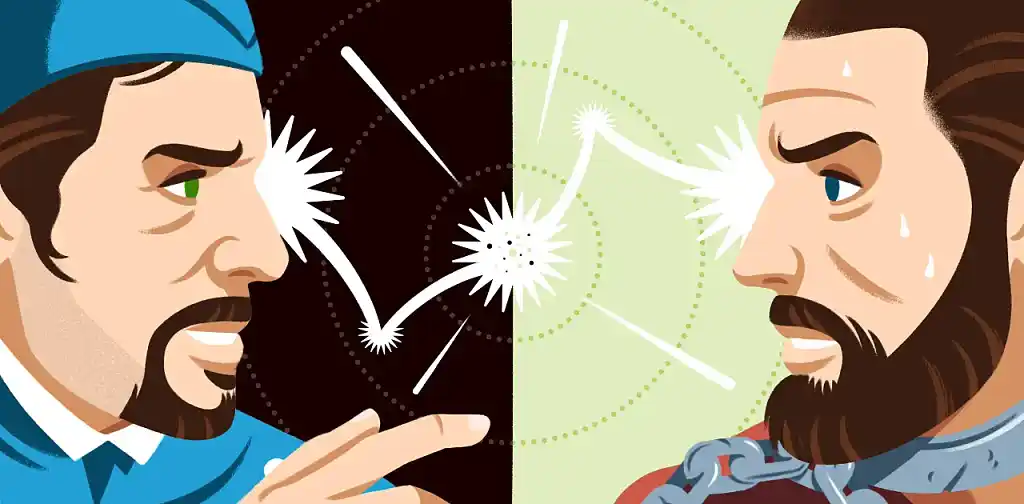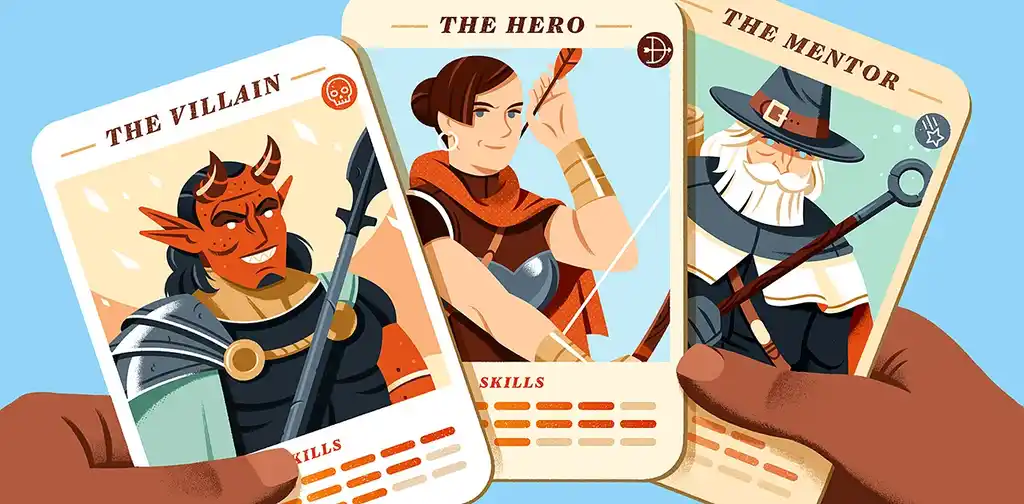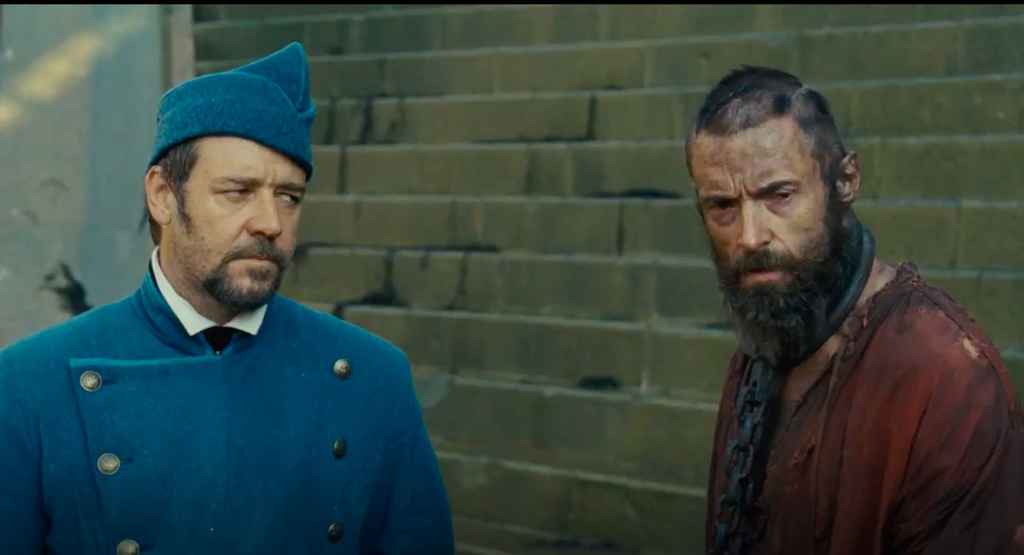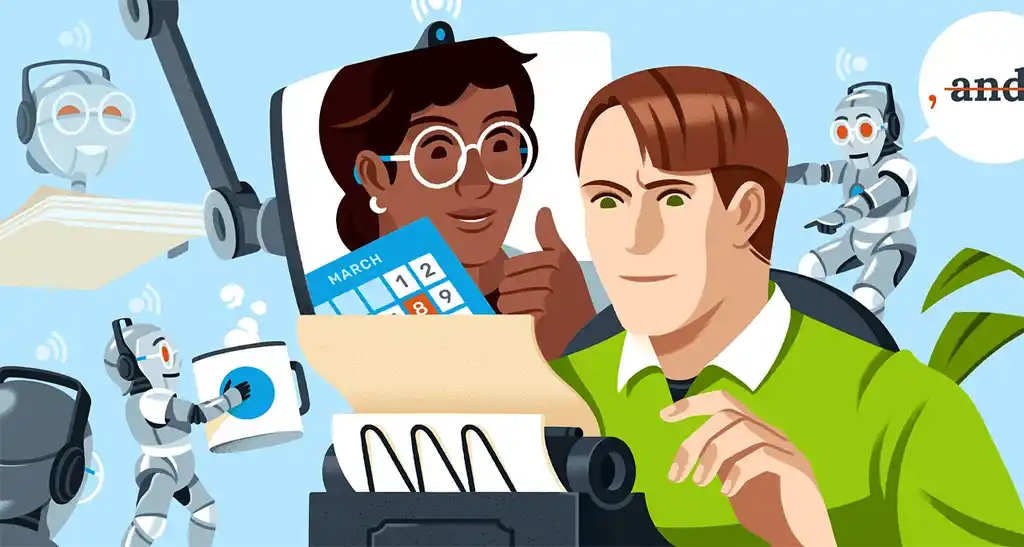Guides • Perfecting your Craft
Posted on Nov 04, 2024
Man vs. Man: The Most Popular Conflict in Literature
Martin Cavannagh
Head of Content at Reedsy, Martin has spent over eight years helping writers turn their ambitions into reality. As a voice in the indie publishing space, he has written for a number of outlets and spoken at conferences, including the 2024 Writers Summit at the London Book Fair.
View profile →It’s Batman and the Joker, Matilda and Miss Trunchbull, Goodies and Baddies! In this article, we’re talking all about “Man vs. Man conflict” and how it forms the basis for a huge chunk of stories across this history of literature. After working through a definition, I’ll show you some of my favorite man-on-man face-offs and give you some tips for writing this type of conflict yourself.
So, who’s up for a fight?
What is man vs. man conflict?
Man vs. man conflict in a story describes the antagonistic dynamic or struggle between two (or more) characters, fuelling many of the stories we enjoy over our lifetimes. Usually it takes place between the protagonist and antagonist, and you'll find it in many different contexts, from a physical face-off to psychological warfare.
At the end of the day, from fairy tales where witches prey on innocent children to superhero blockbusters where Iron Man faces off against a space warlord, this is the most elemental story: one person wants something, and another person wants to stop them from getting it.
Also known as character vs. character conflict, it can co-exist with other types of story conflict. For example, a story about a food cart operator being hounded by a tax auditor could be about interpersonal conflict as well as the fight between an individual and modern society (represented by that government employee).

I suspect that the reason why this type of conflict is so common boils down to how well it works in a visual and visceral sense. Just think about a boxing match, a courtroom argument, or a playground battle of wits over who gets to go down the slide first: it’s easier for readers and audiences to relate to those real-world conflicts than to think about abstract conflicts like “man’s unease with technology”.
Most of the stories we’re exposed to these days are about a protagonist who’s up against a nemesis, so it’s understandable that we can reduce this kind of conflict to just “good guys vs. bad guys.” But that doesn’t have to always be the case.
It doesn’t just have to be heroes and villains
Just because an antagonist is trying to stop the ‘hero’ from getting what they want, it doesn’t necessarily mean they’re villains or even in the wrong. The places where you’ll often find man vs. man conflicts that aren’t good-vs.-evil stories can include:
Anti-hero narratives where the protagonist is morally gray and the antagonist is either on the side of ‘good’ or a fellow villain. Example: Walter White vs. Gus Fring or Hank Schrader in Breaking Bad.
Dual narratives where there are effectively two protagonists — and depending on whose story we’re following at any given time, the other character will be the nominal villain. Example: Christopher Priest’s The Prestige (and the film of the same name) is told through the diaries of two feuding magicians in the late 1800s. The reader’s sympathies will change depending on whose perspective you see things through.

FREE RESOURCE
Reedsy’s Character Development Template
A story is only as strong as its characters. Fill this out to develop yours.
And then you also have stories in which there aren’t necessarily any antagonists — ones where the protagonist might be their own worst enemy. Many romance novels see our hero face a rival who has done absolutely nothing wrong apart from pursuing the same love interest.
So now that we know what we’re looking for in a man vs. man conflict, I want to share some of my favorite examples to show you how diverse this dynamic can be.
Examples of man vs. man conflict
So, let’s start with some classic examples of heroes versus villains before moving to some less popular ones.
Star Wars (Luke Skywalker vs. Darth Vader)
For his 1977 original, writer/director George Lucas took inspiration from Joseph Campbell’s theories on mythology and crafted a story that follows the Hero’s Journey to a tee. Here, we see our hero — a young farmboy dressed in white — venturing out to an unknown world to save a beautiful princess from the villain, an old robot man dressed in black. Only one of them can win the day!
Les Misérables (Jean Valjean vs. Javert)
Former convict Jean Valjean restarts his life with a new identity, seeking to create a more just society for the underclasses. He is discovered and pursued by the dogged Inspector Javert, whose fanatical devotion to the law has blinded him to the actual injustices perpetrated by the system.

Rebecca (The Second Mrs. de Winter vs. Mrs. Danvers)
After a whirlwind romance with an English Aristocrat, a naïve American woman arrives in Cornwall as the new lady of Manderlay, an opulent coastal estate. But no sooner than she drops her bags at the doorstep, she is met by Mrs Danvers, a frosty housekeeper who’s still intensely obsessed with the first Mrs. de Winter, who died on a sailing trip less than a year before. Convinced that her employer’s new wife intends to replace her beloved Rebecca, Mrs Danvers starts a sneaky campaign to undermine the second Mrs. de Winter.
Catch Me If You Can (Frank vs. Carl)
In the film adaptation of con man Frank Abagnale’s spurious memoir, the audience is invited to enjoy the illegal hijinks of young Frank (Leonardo Dicaprio) as he cashes forged checks and fools people into believing he is an airline pilot or a doctor. His main antagonist is FBI Agent Carl Hanratty, with whom he’s engaged in a cross-country cat-and-mouse game. The fact that Hanratty is played by The Nicest Man in Hollywood™️ Tom Hanks helps to humanize the Feds and even out the audience’s loyalty.
The Silence of the Lambs (Clarice Starling vs. Hannibal Lector)
Sent by her supervisor to interview a genius serial killer behind bars, FBI trainee Clarice Starling is tasked with getting Lector’s help to find an active spree killer. Engaged in a battle of wits where conflict bristles just under the surface, Clarice must figure out what Lector knows — and what he wants from her — before it’s too late.

Animal Farm (Snowball vs. Napoleon)
Tired of how poorly their farm is run, two young pigs stage a coup and seize control of their farm in the name of their fellow animals. But what starts as a utopian idea of equality among animals soon goes awry as one of the pigs, Napoleon, starts hogging all the power and begins a purge of all the animals who he believes to be in support of Snowball, the other piggy hero of the revolution. Written as a retelling of the Russian Revolution, Animal Farm’s Napoleon is an obvious replacement for Joseph Stalin — a leader who had no shortage of enemies (real and perceived) and was embroiled in many man vs. man conflicts!
And that’s just the tip of the iceberg. Looking at any novel, playtext, or film, you will find plenty more examples of interpersonal conflict. After all, people dealing with other people is the very core of drama.
So, if you’re a writer, how can you ensure that your man vs. man conflict is firing on all cylinders?
3 tips for writing man vs. man conflict
No matter what medium you’re working in, here are three tips that will help you get the most out of your character conflicts.
1. Make sure your antagonist is believable
Having a villain who just does bad things for the sake of being evil is not very interesting. Even if your bad guy is trying to embezzle money from a care home, give them a believable reason for doing it. (Maybe she needs to provide for her aging parents? Or maybe she believes the care home residents are lizard people from outer space?)

GET ACCOUNTABILITY
Meet writing coaches on Reedsy
Industry insiders can help you hone your craft, finish your draft, and get published.
2. See your antagonist as a reflection of your hero
The best villains often share similar goals to our heroes — they simply have a different way of achieving those goals (Harry and Voldemort are both talented wizards from an early age). By making your antagonist a reflection of your protagonist, you can dramatize what might be going on in your hero’s mind and highlight how they’re more virtuous. Creating this symmetry can also help to humanize the antagonist, which always makes for a more interesting story.
3. Let your characters actually meet each other
This might sound obvious, but if you’re pitting two characters against each other, try putting them together in scenes. There are many examples where protagonists and antagonists don’t meet until the final scene (Rocky, Star Wars). Still, those stories richly benefitted from sequels where these characters interacted a lot more. So, find some way for them to have a conversation, and you’ll be richly rewarded with a strong, tension-filled scene.

